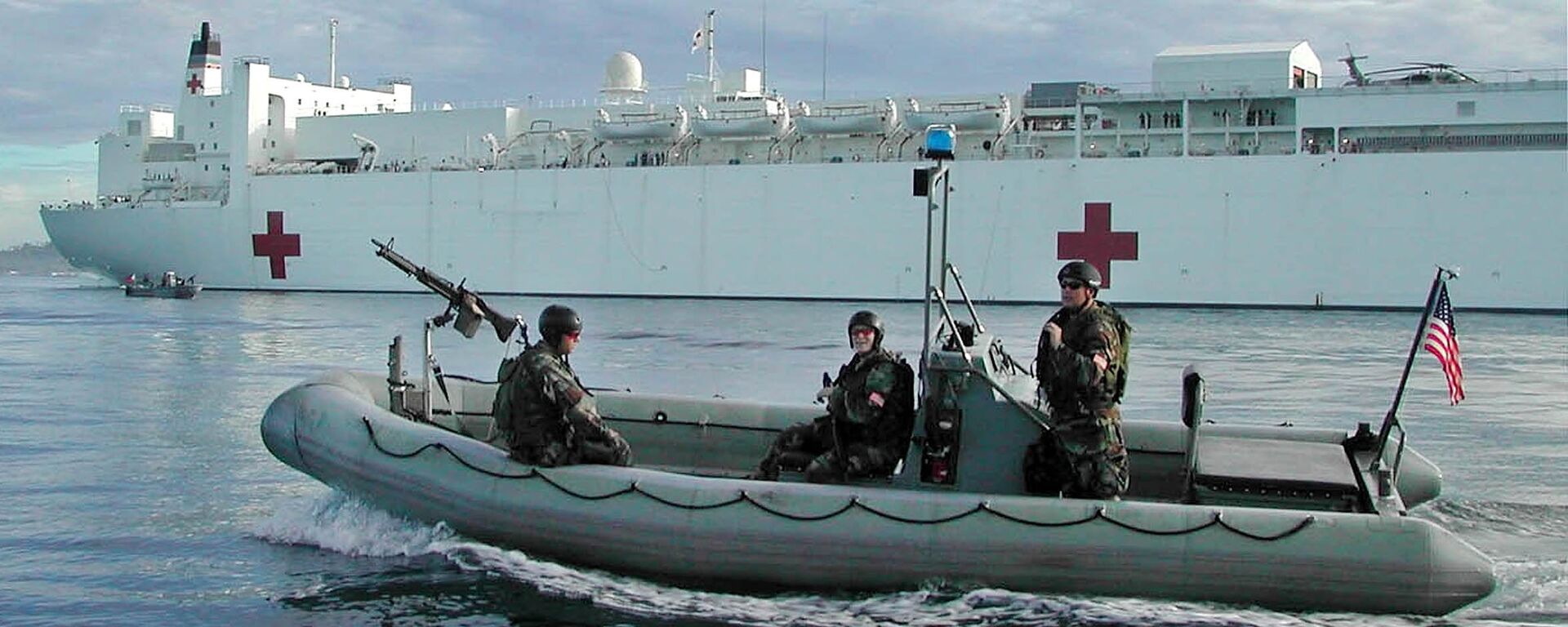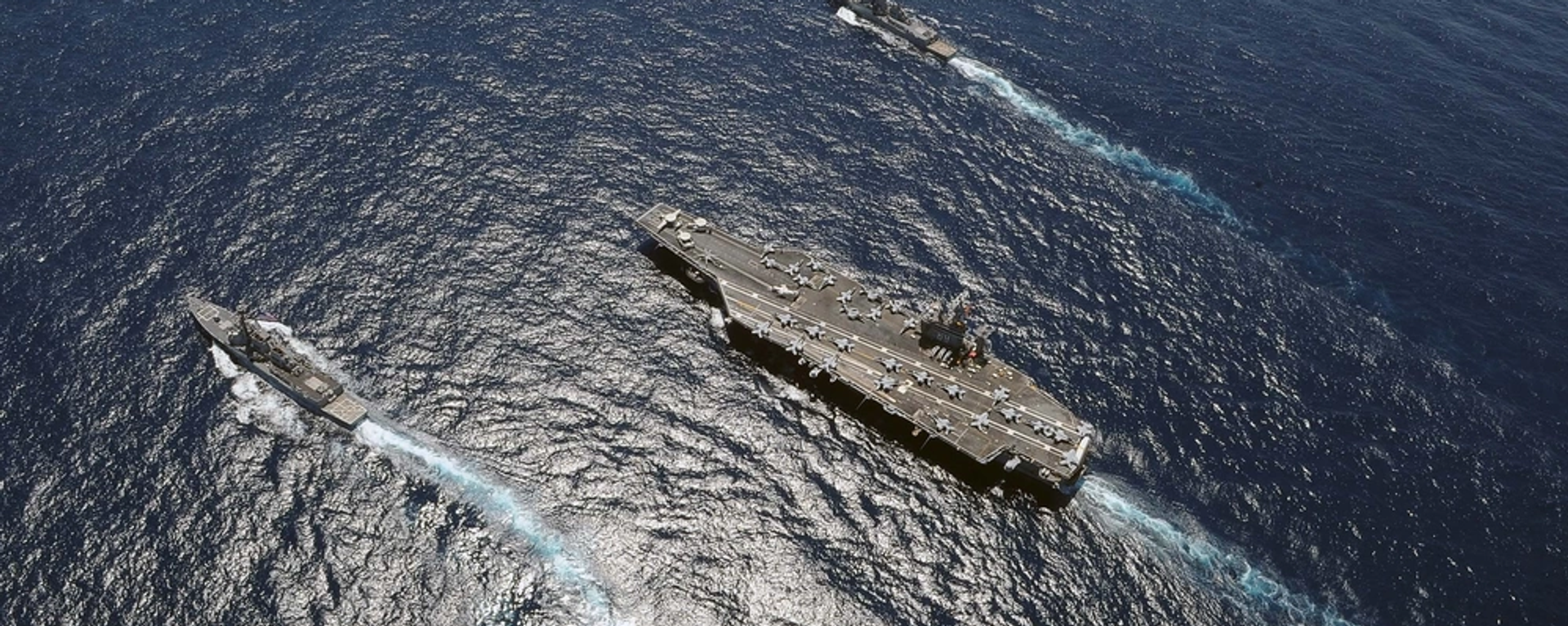https://sputnikglobe.com/20241031/unable-to-wrest-control-of-red-sea-from-houthis-us-and-uk-launch-fresh-strikes-on-key-yemeni-port-1120740607.html
Unable to Wrest Control of Red Sea From Houthis, US and UK Launch Fresh Strikes on Key Yemeni Port
Unable to Wrest Control of Red Sea From Houthis, US and UK Launch Fresh Strikes on Key Yemeni Port
Sputnik International
The US and a handful of its allies began bombing Houthi targets in Yemen in January after the militia closed the Red Sea down to Israeli-linked commercial shipping.
2024-10-31T17:56+0000
2024-10-31T17:56+0000
2024-10-31T17:56+0000
world
red sea
israel
united kingdom (uk)
houthis
houthi
pentagon
red sea crisis
https://cdn1.img.sputnikglobe.com/img/07e8/0a/1f/1120740791_0:161:3067:1886_1920x0_80_0_0_e163beadea1bbca32b804e6a9227a877.jpg
Yemeni television reported Thursday that the US-UK coalition had launched fresh strikes on the strategic Houthi-controlled port city of Hudaydah this morning, saying the strike targeted an area in the city’s al-Hawak district near Hudaydah University.The report did not provide any details on damage or possible casualties. The US-British coalition has yet to comment.City residents reported a “huge explosion” before dawn to China's Xinhua News Agency.Thursday’s attack followed two airstrikes by the coalition targeting the port city’s airport last Wednesday, with those attacks coming shortly after the Houthis announced that they had launched a hypersonic ballistic missile known as the Palestine-2 at an Israeli military base near Tel Aviv.This week’s US-UK strikes came after the Houthis showed off a new submersible naval drone known as the Al-Qaria (lit. ‘The Great Calamity’), and launched another drone attack targeting the industrial zone in the Israeli city of Ashkelon.Hudaydah has been subjected to regular bombings by the US, the UK and Israel in recent months, with warplanes typically targeting local infrastructure after Houthi drones and missiles manage to traverse the 2,000 km+ distance from militia controlled territory into Israel.Port cranes, a power generating station, an oil refinery and oil storage infrastructure were damaged in an Israeli strike that killed 14 people and injured over 90 in July – with the attack serving as the IDF’s response after a Houthi airplane-style drone evaded Israeli air defenses and slammed into a building in Tel Aviv about 100 meters from a US Consulate facility. Israel attacked the city a second time in late September, targeting the port and its airport, after the Houthis launched a Palestine-2 missile toward central Israel.Nearly a year after the Houthis kicked off their campaign of ship seizures, missile and drone attacks designed to deny Israel and its allies access to the Red Sea in solidarity with Gaza, and almost ten months after Washington announced its ‘Operation Prosperity Guardian’ naval campaign to degrade Houthi capabilities and halt the attacks, the militia remains unbowed – engaging in progressively more sophisticated and coordinated attacks using increasingly advanced weaponry.Last week, a US military journal revealed that the Houthis nearly struck American warships in the Red Sea on two separate occasions over the past year, with an incident in June seeing a militia projectile approach to within 200 meters of the USS Eisenhower supercarrier.This week, Germany’s defense minister reportedly ordered a pair of Deutsche Marine warships deployed in Asia to avoid the Red Sea during their long journey back to Europe, with the vessels instead expected to travel around the Cape of Good Hope and up the western coast of Africa thanks to the difficult "security situation" in areas where Houthis operate.The US alone has reportedly spent over $2.5 billion to date on the anti-Houthi deployments, about a tenth of the estimated $22.76 billion it has committed to the Middle East crisis this year.
https://sputnikglobe.com/20241029/houthis-say-attacked-industrial-zone-in-israeli-ashkelon-using-drones-1120713827.html
https://sputnikglobe.com/20241013/deficiencies-gaps-and-inconsistencies-navy-seals-floundering-raid-on-houthi-vessel-revealed-1120527314.html
https://sputnikglobe.com/20241022/houthi-missile-plunked-down-200-meters-from-us-supercarrier-in-red-sea-us-army-journal-reveals-1120644295.html
red sea
israel
united kingdom (uk)
Sputnik International
feedback@sputniknews.com
+74956456601
MIA „Rossiya Segodnya“
2024
News
en_EN
Sputnik International
feedback@sputniknews.com
+74956456601
MIA „Rossiya Segodnya“
Sputnik International
feedback@sputniknews.com
+74956456601
MIA „Rossiya Segodnya“
why can't america defeat houthis, are houthis beating us, who's stronger houthis or us navy, are us strikes on yemen working, why aren't us strikes on houthis working
why can't america defeat houthis, are houthis beating us, who's stronger houthis or us navy, are us strikes on yemen working, why aren't us strikes on houthis working
Unable to Wrest Control of Red Sea From Houthis, US and UK Launch Fresh Strikes on Key Yemeni Port
The US and a handful of its allies began bombing Houthi targets in Yemen in January after the militia closed the Red Sea down to Israeli-linked commercial shipping via a campaign of hijackings, drone and missile attacks. Nearly ten months into the campaign, the Pentagon has yet to achieve its stated aim of “degrading” Houthi capabilities.
Yemeni television
reported Thursday that the US-UK coalition had launched fresh strikes on the strategic Houthi-controlled port city of Hudaydah this morning, saying the strike targeted an area in the city’s al-Hawak district near Hudaydah University.
The report did not provide any details on damage or possible casualties. The US-British coalition has yet to comment.
City residents reported a “huge explosion” before dawn to China's Xinhua News Agency.
Thursday’s attack followed two airstrikes by the coalition targeting the port city’s airport last Wednesday, with those attacks coming shortly after the Houthis announced that they had launched a hypersonic ballistic missile known as the Palestine-2 at an Israeli military base near Tel Aviv.
This week’s US-UK strikes came after the Houthis
showed off a new submersible naval drone known as the Al-Qaria (lit. ‘The Great Calamity’), and launched another drone attack
targeting the industrial zone in the Israeli city of Ashkelon.

29 October 2024, 09:16 GMT
Hudaydah has been subjected to regular bombings by the US, the UK and Israel in recent months, with warplanes typically targeting local infrastructure after Houthi drones and missiles manage to traverse the 2,000 km+ distance from militia controlled territory into Israel.
The Houthis captured Hudaydah in 2021, with the port city populated by over 735,000 residents, and serving as a crucial import-export hub along the Red Sea coast going back to the 19th century. Through the ongoing Yemeni civil war, the city’s port facilities became the entry point for 70%-80% of the international humanitarian aid sent to Yemen, as well as fuel and essential goods deliveries.
Since the escalation of the Yemeni crisis, cargoes entering the city's port have been inspected by UN agents to ensure that no weapons are delivered using the port.
Port cranes, a power generating station, an oil refinery and oil storage infrastructure were damaged in an Israeli strike that killed 14 people and injured over 90 in July – with the attack serving as the IDF’s response after a Houthi airplane-style drone evaded Israeli air defenses and slammed into a building in Tel Aviv about 100 meters from a US Consulate facility. Israel attacked the city a second time in late September, targeting the port and its airport, after the Houthis launched a Palestine-2 missile toward central Israel.
Nearly a year after the Houthis kicked off their campaign of ship seizures, missile and drone attacks designed to deny Israel and its allies access to the Red Sea in solidarity with Gaza, and almost ten months after Washington announced its ‘Operation Prosperity Guardian’ naval campaign to degrade Houthi capabilities and halt the attacks, the militia remains unbowed – engaging in progressively more sophisticated and coordinated attacks using increasingly advanced weaponry.

13 October 2024, 03:05 GMT
Last week, a US military journal revealed that the Houthis nearly struck American warships in the Red Sea on
two separate occasions over the past year, with an incident in June seeing a militia projectile approach to within 200 meters of the USS Eisenhower supercarrier.
This week, Germany’s defense minister reportedly
ordered a pair of Deutsche Marine warships deployed in Asia to avoid the Red Sea during their long journey back to Europe, with the vessels instead expected to travel around the Cape of Good Hope and up the western coast of Africa thanks to the difficult "security situation" in areas where Houthis operate.
The US alone has reportedly spent over $2.5 billion to date on the anti-Houthi deployments, about a tenth of the estimated
$22.76 billion it has committed to the Middle East crisis this year.

22 October 2024, 18:08 GMT





